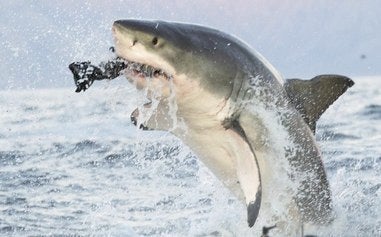
The stars of Shark Week, great white sharks, are in trouble off the coast of California. Unfortunately, a recent scientific estimate of this population showed less than 350 adult great white sharks left in the population found off the US west coast, putting this important great white population in serious danger of going extinct. The famous white sharks of the Farallon Islands and Guadalupe Island could disappear completely.
White sharks, some scientists believe, first migrated to California from Australia almost 200,000 years ago. They stayed put, and through that geographic isolation became genetically unique from the Australian population and other great white shark populations around the world.
Little is known about how great white sharks reproduce or where they give birth. But we do know that every pup is very important to the future of the species because great whites grow very slowly and have very few pups over their lifetime. And, we also know that soon after the sharks are born they tend to congregate around underwater canyons off the Southern California Coast and across the border into Mexican waters. These canyons are rich with fish and serve as a nursery for the young to grow up in. A newborn great white shark is born ready for the ocean -- about six feet long with rows of razor sharp teeth and powerful jaws. They differ from adult great whites in that they primarily eat fish, as they are not big enough to eat seals or sea lions.
In Southern California, gillnetters catch California halibut, yellowtail, white sea bass, thresher sharks and swordfish. Gillnets can be anchored in place or drift with ocean currents. Some drift gillnets can reach nearly a mile long, and are designed to catch fish by entangling them. The fishermen catch the white sea bass and swordfish this way but they also incidentally catch other fish -- including young great white sharks who swim into the nets when migrating or chasing after a meal. Once caught in the net the sharks often die. Of the reported fishery interactions in the past 30 years, there have been an average of at least 10 white shark interactions per year and over 80% of the great white sharks caught in their nursery grounds are caught by these gillnetters. However, these are only reported interactions, and the actual bycatch is likely much higher. Fishermen are not allowed legally to target or sell these sharks; but, there is no law prohibiting gillnetters from setting their nets in great white nursery grounds, nor are there limits on the bycatch of white sharks in U.S. or Mexican fisheries.
Great whites have survived for millions of years, surviving mass extinctions and rightfully earning their top spot as apex ocean predators. But unless we increase protections for them, they may not survive much longer.
In an effort to save these sharks, Oceana, Center for Biological Diversity, and Shark Stewards filed a petition last week to list this important population of great whites as endangered species. The classification would bring with it protections and additional research dollars for this dangerously low population and Oceana is collecting signatures in support of this petition to help secure a victory. Although California does have rules against catching and selling great white sharks and has recently banned the shark fin trade (thanks in part to Oceana), they haven't done enough to stop this capture of young great whites as bycatch. And, this new listing would help.
Shark Week is a great time to get involved. Tune in on August 16th to see actor and Oceana board member Ted Danson narrate Great White Highway a show about the mysterious lives of great whites in California and find out more about how you can help protect them at www.oceana.org/sharkweek.